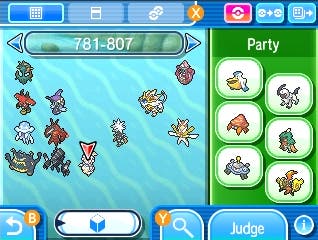Pokémon Living Pokédex guide - tips for a complete living dex in Gen 7's Ultra Sun and Ultra Moon
A guide to catching and storing all 807 Pokémon using just Gens 6 and 7.
The Living Dex is the ultimate Pokémon player's goal, requiring a considerable amount of time and patience.
It's a challenge, basically, even more so than completing the full National Pokédex and second only to that goal of the truly fanatical who want to catch a Shiny version of every Pokémon too.
It takes most players weeks, months or even years to complete, depending on how much of a head start you have and how efficiently you go about it, but worse still there's just no clear way or place to start.
That's where we can hopefully help: here in our Pokémon Living Dex guide for Gen 7 you'll find our step-by-step guide to setting up and preparing for the challenge, as well as all of our tips for creating a Living Dex for when you get to the task at hand. We'll also link out to some handy resources you can use along the way, list everything you need (like the games themselves) to get started, and explain any particularly tricky moments you might encounter, too.
On this page:
- Complete Pokédex vs. Living Pokédex - what's the difference between a National Pokédex and a full Living Dex?
- Pokémon Living Pokédex guide - how to get a Living Dex in Pokémon Gen 7 and setting up
- Pokémon Living Pokédex tips - general and game-specific advice for completing your Living Pokédex
- Hard to catch Pokémon for the Living Dex, and how to get them
Complete Pokédex vs. Living Pokédex - what's the difference between a National Pokédex and a full Living Dex?
In brief, a Living Dex is not just a complete, National Pokédex of Pokémon caught - it's having a living version of all 806 currently-available Pokémon stored in your boxes or Pokémon Bank.
For example, that means not just having the Venusaur you evolved up from your starter Bulbasuar, but an actual Bulbasaur and Ivysaur stored in your box too. So for every three-stage evolution that means you need three different Pokémon.

A regular National Dex, by contrast, just requires you to have had those Pokémon in your possession at some point in time. It seems like a minor difference, but as you'll discover below it can get rather long-winded when you consider the sheer scale of the Pokédex in full.
Thankfully, there are now plenty of resources available to help, from tons of storage in the Pokémon Bank to items like the Oval Charm for speeding up breeding, and the GTS for trading with anyone, anywhere.
Below, we'll take you through everything you need to not just complete your National Dex, but get the full, completionist's dream of the Living Dex - we only really detail the latter, but of course in completing that you'll be completing the former along the way.
Pokémon Living Pokédex guide - how to get a Living Dex in Pokémon Gen 7 and setting up
The Living Dex is a huge undertaking, and so if you want to do it properly, you're going to need to prepare well. Setting up, in fact, is a lengthy enough process as it is, but after ticking off all of the below you'll be in a great position to get started and hopefully continue on your catching quest uninterrupted by diversions for various items or objectives along the way.
How to prepare for getting a Living Dex:
Step 1 - You need a copy of either Omega Ruby or Alpha Sapphire (ORAS), plus a copy of either X or Y (XY), and finally a copy of either Pokémon Ultra Sun or Ultra Moon (USUM). This is because between ORAS and XY, the only unobtainable Pokémon are mythicals (which you need to get from events or trade for) and those newly introduced in Gen 7 (which can all be caught/traded for from USUM).
If you have the opposing versions from each Gen and two systems then that's great for cutting down trading time, but otherwise one from each is fine - it's no major issue to just trade one version exclusive for another on the GTS down the line.

Step 2 - Organise your boxes in all editions. The idea is to label them according to the National Pokédex numbers of the Pokémon that you'll put in each, so you can see everything in order and fill in the gaps as you go.
This works out as Box 1 being 1-30, Box 2 being 31-60, and so on. Leave several spare boxes at the end for shinies, event Pokémon, Alolan forms and so on, plus the below.
Step 3 - Label several more boxes for "To Breed", "To Evolve: Level", "To Evolve: Trade", "To Evolve: Item", "To Evolve: Other" (a great tip from redditor OiseauRouge. This helps you bulk breed, level, and trade Pokémon down the line.
Put those Pokémon that require two or more of the above into the box that needs to be done first. Eg: If you have a Venusaur but need both Bulbasaur and Ivysaur, put Venusaur into To Breed, then one of the two hatched Bulbasaur into To Evolve: Level once it's hatched, so you can get Ivysaur.
Step 4 - Open up a Pokédex tracker like this one (aptly called Pokédex Tracker...) to cross off every Pokémon you've caught and put into your Pokémon Bank/Boxes.
Usefully, it's also split into groups of 30, which means you can copy out the group numbers to your Storage Box names and save on the mental maths.
Step 5 - Transfer all Pokémon from games you're not playing anymore to Pokémon Bank (we explain how to use that in our Pokémon Bank guide).
Organise them into their numbers in the labelled boxes above in the game you've decided to store them all in - the best bet is probably Ultra Sun and Ultra Moon seeing as they're the most recent, and you'll still be taking Pokémon in and out to breed and so on, so it's better to keep uncomplete boxes in-game rather than in Bank for now.
Having all of your unused Pokémon in one place will make it much easier to catalogue your progress. Keep your regular squad and utility Pokémon (like HM slaves, hatchers, catchers and so on) back in your Gen 6 and 7 games though, as you'll still need them.
Step 6 - Now, complete the main story of the games you're going to be using (one from ORAS, one from XY, one from USUM) including the Legendary stories and the Elite Four.
Catch every Pokémon you see along the way that you haven't already caught, but don't worry about catching every Pokémon in every patch of grass as you go, because it'll be faster to come back later with higher level, specialised Pokémon and items for catching.
We recommend doing this one at a time, rather than chopping between the three or more games you're using, but there's no perfect order - just have fun for now!
One thing to bear in the mind is the various "levellable" utilities that you pick up along the way - in USUM, use the Roto Loto as soon as it's available to collect as many of the useful boosts as possible without having to grind for them later.
With Gen 6, pick up the O-Powers as you go and use them along the way too to get them levelled. Focus on hatching, catching and levelling boosts in particular. With the stories complete, it'll be much easier to get all kinds of things done, and you'll have a nice chunk of Pokémon caught from along the way, too.

Step 7 - Now, it's time to get a 'catcher' Pokémon for each game, if you don't have one already. They will need: False Swipe; a Paralyzing/Sleep-inducing move like Hypnosis, Yawn, Spore, or Thunder Wave; and ideally other utility moves like Soak/Foresight for hitting Ghost Pokémon that are immune to False Swipe.
Also go for Taunt for Pokémon that usually flee or use other awkward attacks like Roar, Perish Song or like to heal; Mean Look if it can't learn Taunt; or maybe an added STAB damage move to help whittle Pokémon down. Great examples include: Gallade, Breloom, Parasect, Absol, and Smeargle.
Step 8 - While you're at it, get a 'hatcher' Pokémon too, which needs to have the Flame Body ability that speeds up Egg Hatching times. Pick up a Ditto while you're at it, if you don't already have one!
This will set you up to for putting five Eggs into your squad and hatching as quickly as possible. Hatcher examples include: Magby evolution line; Slugma evolution line; Fletchinder; Talonflame; Litwick evolution line; Larvesta evolution line.
Step 9 - Get a Lucky Egg or, if possible in your version, multiple Lucky Eggs, to speed up XP gains for Pokémon you'll need to evolve.
Step 10 - Get a high-level 'sweeper' Pokémon with a good range of attack types that can plough through enemies to level up the rest of your party quickly. In Gen 6, it will really help if it has a move or two that can hit multiple enemies, for you to clear out hordes.
In USUM, you just want as much type coverage as possible and all-round bulk. Get it nice and high-level from your main playthrough, as it'll really come in handy!
Step 11 - Get a Manaphy or it's baby evolution Phione, either by event distribution or the GTS - this is because it's the only breedable mythical Pokémon, and is thus both very rare and in-demand on the GTS, but still easy enough for you to multiply for trades without 'cheating' by cloning it. It's a fantastic way to trade fairly for rare, Legendary or Mythical Pokémon.
Now, at last, you should have:
- A couple hundred Pokémon logged in your numbered boxes already (or even more, if you transferred a lot of Pokémon from older generations like Black/White)
- A Pokémon for trading multiple hard-to-finds on the GTS
- A Pokémon for catching
- A Pokémon for breeding and hatching
- The resources for levelling up.
Finally, you can start the long task of catching the remaining Pokémon in each of your versions.
Pokémon Living Pokédex tips - general and game-specific advice for completing your Living Dex
So, you're finally all set up and probably very impatient to get started on the actual catching part. Here are our tips for doing it - starting with some general advice and then going into some specific tips for each version you'll be using.
General Living Dex tips:
- Do your initial playthroughs one at a time - once you have 100-200 Pokémon from one playthrough, that can save you significant time catching others as you go in other playthroughs, because you know what you already have and won't have to bother with duplicates.
- The same goes for the Pokédexes themselves. It's probably best to start with Gen 7 (USUM), as it has the fewest gimmicks for how to catch Pokémon, unlike the DexNav, Mirage spots, etc. from other gens. It's also the most recent generation, so the smartest place to store your Dex (outside of Pokémon Bank), so it makes sense to start here and cut out a good chunk of transferring and cross referencing.
- Once you've filled a box, like "1-30", upload it to Pokémon Bank. It's safer there than on a game cartridge that could get lost or corrupted! Alternatively, keep it on the cart for ease of access if you need to breed or trade anything, and use a third-party device like PowerSaves to backup your saves on PC at regular intervals - note that this isn't an official Nintendo product though, so proceed with caution.
- Always catch spares for Pokémon that need to evolve when it's possible - so three Bagon, for instance, because of both Shelgon and Salamence that evolve from it.
- A major slowdown is that some Pokémon are only available in some combination of either the Friend Safari (XY), DexNav (ORAS) and Mirage Spot (ORAS) features, unless you go back to Gen 5 or earlier. At that point you just need to choose what's easiest for you - DexNav and Mirage Spots are probably easier for solo players, but if you're lucky enough to have the more than a dozen 3DS friends required to pad out the Friend Safari in X and Y, that may be the easier option. Better yet, you could always use some of your rarer Pokémon (like that swathe of Phione we mentioned above) to trade on the GTS.
- Use the Pokédex Tracker site we mentioned above to quickly see at-a-glance where each Pokémon is available, and maybe keep a spreadsheet or list open as well to mark down any notes for Pokémon to come to later so you don't forget. You might see that a Pokémon is only available via SOS-Battle in Ultra Sun and Ultra Moon, but is easily catchable in the wild in ORAS, for example, so even if you're playing USUM at the time it's probably faster to just make a note of it and come to it when you tackle ORAS down the line.
- Do your breeding and hatching in Gen 7 (USUM) - that's because it's the easist game to get the Oval Charm in (by becoming champion and defeating Morimoto and Iwao in the Game Freak offices). It's an item that speeds up the rate Pokémon successfully lay Eggs, which makes your life a little easier when breeding.
- Levelling, meanwhile, is arguably easiest in Omega Ruby and Alpha Sapphire, thanks to the relative abundance of Lucky Eggs there, and the existence of Blissey Bases (a little more on this below).
Pokémon X and Y Living Dex tips:
- Some Pokémon are exclusive to the Friend Safari. Unless you have loads of 3DS friends, it's probably easier to get them in a different version.
- Level up your useful O-Powers as you get them! Hatching, catching and experience-based powers are the most useful.
- You get the Oval Charm for completing the Regional Pokédex here. It's useful, but you can get it faster in USUM, so when your "To Breed" box is full here, send it over to USUM where it can be done faster.
- X and Y feature hoards, which are a nice way to level quickly if you don't fancy the Elite Four on repeat.
- You get the Lucky Egg from a woman in Coumarine City Hotel with blonde hair, if the first Pokémon in your party likes you enough.
Pokémon Omega Ruby and Alpha Sapphire Living Dex tips:
- The DexNax is an important tool, although it's less useful for completing your Pokédex as it is for catching Pokémon you've already found. Some Pokémon are exclusive to this, and it can be long-winded, as you're at the behest of RNG when it comes to finding Pokémon you haven't seen before. Make sure you have repels to stop other wild Pokémon disrupting your sneak-up on the one you actually want, and remember a lot of Pokémon are unlocked as available for this after you complete the Primal Kyogre or Groudon part of the story.
- Secret Bases, especially Blissey Bases, are known as one of the best ways to level up. Redditor rebellionmarch explains them well.
- Like with X and Y the Oval Charm is slow to come by, so save breeding for USUM.
- Hoards are also a thing here, and come in handy for levelling.
- Lucky Eggs are much easier to come by in ORAS, thanks to the fact that wild Pelipper have a chance of holding one. People tend to farm them by using the DexNav to find Pelipper easily, and then using the move Thief to steal it from them, and repeating. When you have six, giving one to each Pokémon in your party is a great way to rapidly level up.
- Mirage Spots are a bit cumbersome, requiring you to fly around on Latios or Latias until one appears, and they don't appear often or in any predetermined way. Best to avoid using these unless you absolutely have to!
Hard to catch Pokémon for the Living Dex, and how to get them
Finally, here's a quick look at some of the most awkward Pokémon you'll be encountering - or trying to encounter - along the way, and our tips for catching them, or least making it a little easier!

- Cosmog and Cosmoem - Spoilers for Gen 7 stories here, if you haven't already finished them. You've been warned! As you'll discover in your playthroughs of the Gen 7 story, Cosmog is actually the first part of a three-part legendary evolution line for Cosmoem, and then either Solgaleo or Lunala. In Sun and Moon and their enhanced editions you'll get a Cosmog and either a Solgaleo or Lunala, but that still leaves you with the other version's legendary and the Cosmoem to get for your Living Dex. The easiest solution is to have the opposite game version - maybe you have regular Sun and Ultra Moon (which is the case for us) - and then you can evolve the Cosmog to Cosmoem in your second version, catch that version's legendary and you're all set. Otherwise? You'll have to get trading. Head to Smogon's message boards and the pokémontrades subreddit, where there are always people happy to help!
- Mythical Pokémon - these Pokémon are only ever available via special event distribution. Think Mew, Celebi, and more recently Shaymin, Genesect, Darkrai and Marshadow. If you miss a distribution (the entire roster was actually given away just over a year ago) then you have two options: wait for the next one, or trade online via the same links above. Just beware that it becomes increasingly difficult to find "genuine", non-cloned and more importantly non-hacked versions of Pokémon the rarer they are. The Manaphy-Phione method we mentioned above (get one and breed it for more Phione to trade away) is a decent way to start.
- Gen 4 and 5 Pokémon - a lot of these are only available in Gens 6 and 7 via the Friend Safari (XY) and Mirage Spots (ORAS), which are both limited and time-consuming, as we mentioned above. One thing you can do is get the maximum amount of Pokémon you can per day from the parts of these that you can access - Mirage Spots only appear once per day, for instance - and then trade them online for the others. Alternatively it really helps if you can have a copy of Black or White (or their sequels) to hand, but that's obviously another major step.
- Item-trade Pokémon - the likes of Weavile, Slowking and so on can be pretty akward to get, thanks to the relative rarity of items like King's Rock and the fact that because of that item scarcity and unlike say Haunter or Machoke, there are fewer up for grabs on the GTS that will evolve on arrival. Your best bet is to find a friend who you can do trades with - this goes for general trade evolutions too!
And that's just about it! Remember to keep track of your progress by filling out your boxes in order and ticking off Pokémon on your tracker of choice, make notes as you go where needed, and take it easy! When you don't rush, the methodical nature of Pokédex-filling can be quite relaxing, so set yourself modest targets and remember to have fun.
Let us know how you get on!









